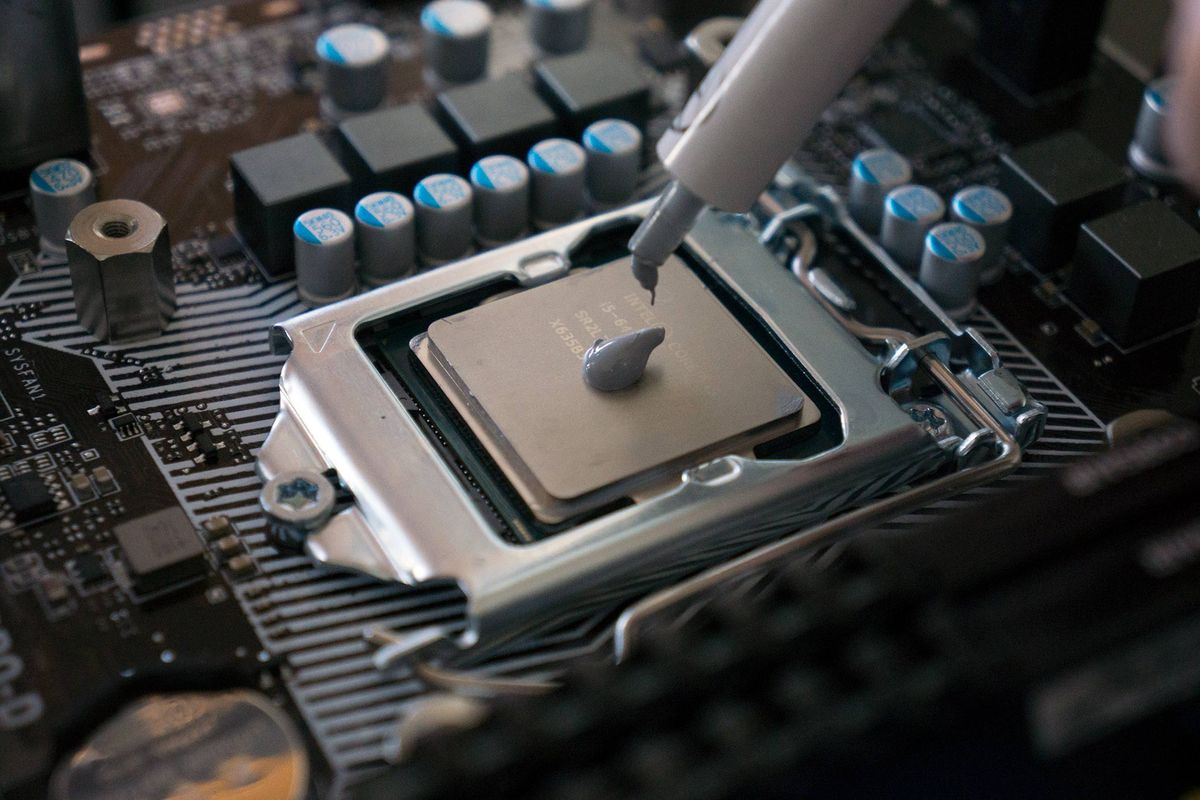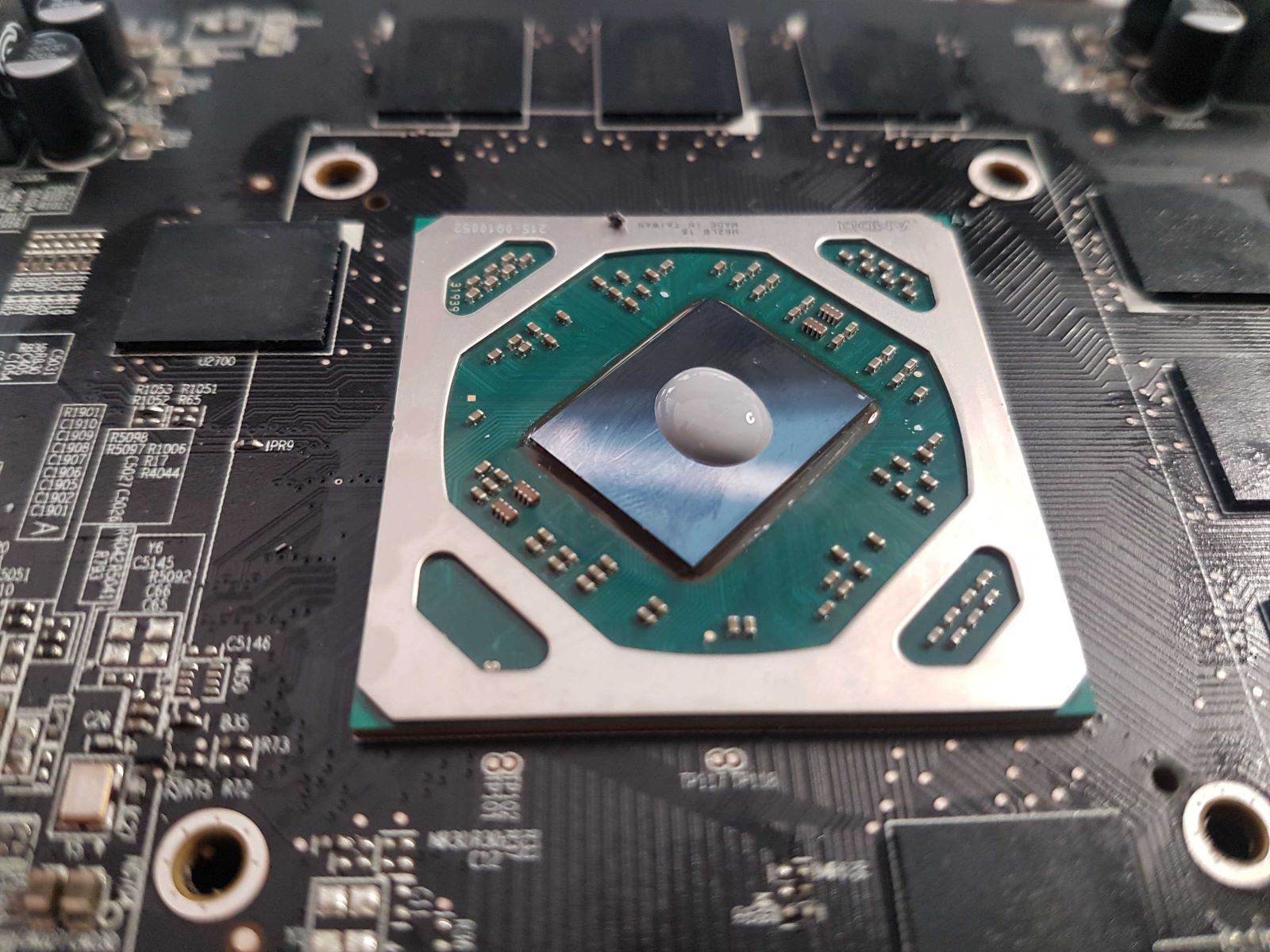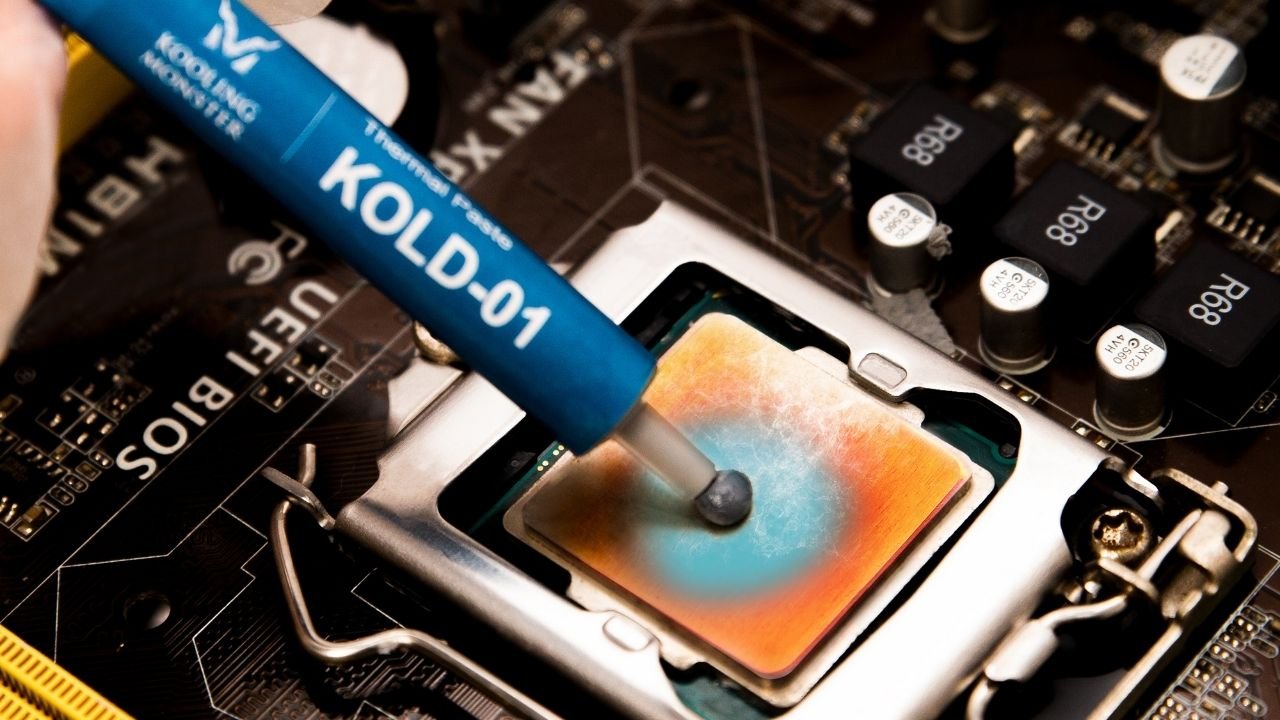Introduction
When it comes to maintaining the optimal performance and temperature of your CPU, proper thermal paste application is essential. Over time, the thermal paste that sits between the CPU and the heatsink can degrade and lose its effectiveness, leading to increased temperatures and potential performance issues. That’s why it’s important to know how often you should repaste your CPU.
Thermal paste, also known as thermal compound or thermal grease, is a heat-conductive substance that fills the microscopic gaps between the CPU and the heatsink. Its primary purpose is to improve the transfer of heat from the CPU to the heatsink, allowing for efficient cooling. However, as thermal paste ages, it can dry out, become less effective, and cause the CPU to overheat.
So, how can you tell when it’s time to repaste your CPU? One of the most obvious signs is when you start noticing high idle or load temperatures. If you find that your CPU is running hotter than usual or if you’re experiencing sudden thermal throttling, it might be a clear indication that the thermal paste needs to be replaced. Additionally, if you’ve recently upgraded your CPU cooler or have been experiencing system instability, repasting the CPU could help to resolve these issues.
Several factors can influence how often you should repaste your CPU. One of the key factors is the quality of the thermal paste you’ve used. High-quality pastes generally have a longer lifespan, while lower-quality ones may require more frequent repasting. Another factor is the operating conditions of your system. If you often push your CPU to its limits or if your environment has high ambient temperatures, you may need to repaste more frequently.
Understanding thermal paste
Thermal paste, also known as thermal compound or thermal grease, is a crucial component in ensuring proper heat transfer between the CPU and the heatsink. It is a grayish or white substance that fills in the microscopic imperfections on the surface of the CPU and heatsink. By doing so, it improves the conduction of heat from the CPU to the heatsink, allowing for effective cooling.
The main ingredient in thermal paste is typically a mixture of silicone compounds, such as silicone oil or silicone grease. These compounds have excellent thermal conductivity properties, which help to dissipate heat efficiently. In addition to the silicone compounds, thermal pastes may also contain additives like metal oxides or ceramic particles, which further enhance their thermal conductivity.
The application of thermal paste is crucial for creating a smooth and continuous interface between the CPU and the heatsink. This eliminates any air gaps that may impede the transfer of heat. Without thermal paste, the irregularities on the metal surfaces of the CPU and heatsink can create air pockets, reducing the efficiency of heat transfer and leading to higher temperatures.
When applying thermal paste, it’s important to use an appropriate amount. Too little thermal paste can leave gaps and hinder heat transfer, while applying too much can create excessive thickness and reduce cooling efficiency. The ideal application is a thin, even layer that covers the entire surface of the CPU heat spreader.
Furthermore, it’s worth noting that not all thermal pastes are the same. Different brands and types of thermal pastes have varying performance characteristics. Some thermal pastes are designed for high thermal conductivity and long-term stability, while others prioritize ease of application. It’s essential to choose a thermal paste that suits your specific needs, considering factors such as thermal performance, longevity, and ease of use.
Signs that it’s time to repaste your CPU
As thermal paste ages, it deteriorates and becomes less effective in transferring heat from the CPU to the heatsink. This can lead to increased temperatures, which can adversely affect the performance and lifespan of your CPU. To ensure optimal cooling and prevent potential issues, it’s essential to be aware of the signs that indicate it’s time to repaste your CPU.
One of the most noticeable signs is a significant increase in CPU temperatures. If you monitor your CPU temperatures regularly and notice a sudden spike in temperatures during idle or under load, it could be an indication that the thermal paste has dried up or degraded. Higher temperatures can lead to thermal throttling, reduced performance, and even system instability.
Another sign that it’s time to repaste your CPU is if you’ve recently upgraded your CPU cooler or replaced other components in your system. Whenever you make changes to your cooling setup, it’s a good idea to check the condition of the thermal paste and consider repasting if necessary. This helps to ensure that you’re getting the most out of your new cooler or components and maintaining optimal cooling efficiency.
You may also need to repaste your CPU if you’ve been experiencing system instability such as random crashes or blue screens of death (BSODs). In some cases, inadequate thermal paste application or degraded thermal paste can lead to improper heat dissipation, causing the CPU to overheat and triggering system instability.
Aside from temperature-related symptoms, another sign to look out for is the appearance of the thermal paste itself. If you visually inspect the thermal paste and notice that it has become dry, hardened, or discolored, it’s a clear indication that it’s no longer effective and should be replaced.
Ultimately, it’s important to keep track of your CPU temperatures, periodically inspect the condition of the thermal paste, and pay attention to any signs of system instability. By doing so, you can identify when it’s time to repaste your CPU and ensure optimal cooling performance for your system.
Factors to consider when deciding how often to repaste
The frequency at which you should repaste your CPU depends on various factors. While there is no one-size-fits-all answer, considering these factors can help you determine how often you should perform this maintenance task.
One of the key factors to consider is the quality of the thermal paste you’re using. Higher-quality thermal pastes generally have better longevity and can maintain their effectiveness for longer periods. On the other hand, lower-quality thermal pastes may require more frequent repasting as they may dry out or degrade more quickly.
The operating conditions of your system can also impact how often you need to repaste. If you frequently run your CPU at high loads or under demanding tasks, it generates more heat, placing greater stress on the thermal paste. Additionally, if you live in a region with high ambient temperatures or have inadequate cooling in your system, it can lead to more frequent repasting requirements.
Another factor to consider is the age of your current thermal paste. Over time, thermal paste naturally degrades and becomes less effective. If you’ve been using the same thermal paste for an extended period, it’s worth considering repasting to ensure optimal heat transfer and cooling efficiency.
Additionally, be mindful of any changes you make to your cooling setup. If you recently upgraded your CPU cooler, it can be an opportune time to repaste the CPU. This ensures that you’re maximizing the benefits of the new cooler and setting a solid foundation for efficient heat dissipation.
Lastly, it’s crucial to consider your own comfort level and preference for maintenance. Some enthusiasts may enjoy performing regular maintenance tasks on their system and repaste their CPU more frequently to maintain peak performance. Others may opt for longer intervals depending on their needs and the recommendations of the thermal paste manufacturer.
By taking into account these factors, you can make an informed decision on how often to repaste your CPU. Remember that regular monitoring of temperatures and visual inspection of the thermal paste can help you assess its condition and determine when it’s time for a refresh.
How often should you repaste your CPU?
Determining the optimal frequency for repasting your CPU depends on several factors, including the quality of the thermal paste, operating conditions, and personal preference. Although there is no definitive answer, here are some general guidelines to help you decide how often you should repaste your CPU.
As a general rule, it is recommended to repaste your CPU every 1-2 years. This timeframe ensures that the thermal paste remains effective and maintains proper heat transfer between the CPU and the heatsink. However, keep in mind that this is a guideline and may vary depending on your specific circumstances.
If you’re using a high-quality thermal paste with excellent longevity and stability, you may be able to extend the repasting interval closer to the 2-year mark. High-quality pastes tend to retain their effectiveness for longer, reducing the need for frequent repasting.
On the other hand, if you’re using a lower-quality thermal paste or you frequently push your CPU to its limits, you may need to repaste more often, potentially closer to the 1-year mark. These factors can accelerate the degradation of thermal paste, reducing its effectiveness at heat transfer.
Additionally, consider the operating conditions of your system. If you live in an environment with high ambient temperatures or if your system runs in a hot environment, more frequent repasting may be necessary to compensate for the increased heat stress on the thermal paste.
Ultimately, it is essential to monitor your CPU temperatures regularly. If you notice a significant increase in temperatures, it could be an indication that repasting is needed. Visual inspection of the thermal paste can also help determine its condition and whether it needs to be replaced.
Lastly, listen to your own comfort level and personal preference when it comes to maintenance. Some individuals may prefer to repaste their CPU more frequently to ensure optimal performance and temperature management, while others may prefer longer intervals based on their needs and hardware specifications.
Remember, the goal of repasting your CPU is to maintain efficient heat transfer and prevent overheating. By considering the quality of the thermal paste, operating conditions, and your own preferences, you can determine the most suitable repasting interval for your specific setup.
Steps to repaste your CPU
Repasting your CPU may seem daunting, but it’s actually a straightforward process that can be done with a few simple steps. Here’s a guide to help you through the repasting process:
- Gather the necessary tools: Before starting, ensure that you have all the tools you need. This typically includes rubbing alcohol, lint-free cloths, thermal paste, and a screwdriver (if needed to access the CPU).
- Prepare your workspace: Find a clean, well-lit area to work on. It’s important to have a stable workspace and to avoid static electricity, so consider using an anti-static mat or grounding yourself by touching something metal before handling any components.
- Power down and disconnect: Shut down your computer and disconnect the power source. This is crucial to avoid any electrical damage during the repasting process.
- Access the CPU: If necessary, remove the CPU cooler to access the CPU. This involves unscrewing any retaining brackets or screws, gently unplugging the cooler from the CPU fan header, and carefully lifting the cooler off the CPU.
- Clean the CPU and heatsink: Use a lint-free cloth or cotton swab dampened with rubbing alcohol to carefully clean the old thermal paste from the CPU heat spreader and heatsink surfaces. Ensure that both surfaces are completely clean and free from any residue or debris.
- Apply the thermal paste: Take a small amount of thermal paste (approximately the size of a pea) and apply it to the center of the CPU heat spreader. Use a spreading tool, a plastic card, or the edge of the thermal paste tube to spread the paste evenly across the heat spreader. Aim for a thin, even layer that covers the entire surface.
- Reattach the CPU cooler: Carefully lower the CPU cooler back onto the CPU, aligning it with the mounting holes or brackets. Make sure that the cooler is properly seated and secure it in place using the retaining brackets or screws. If your cooler requires thermal paste on its base, apply a small amount following the manufacturer’s instructions.
- Power up and monitor: Reconnect any power cables, power up your computer, and monitor the CPU temperatures. Ensure that the temperatures are within normal ranges and that the CPU cooler is functioning properly.
Remember to consult your CPU and cooler manufacturer’s instructions for any specific guidelines or precautions related to repasting. It’s also essential to use an appropriate amount of thermal paste to avoid excessive thickness or spillage, as this can negatively impact cooling performance.
Following these steps will help you successfully repaste your CPU and ensure efficient heat transfer, helping to maintain optimal performance and temperature management for your system.
Tips for extending the lifespan of thermal paste
Proper care and maintenance can help extend the lifespan of your thermal paste, ensuring optimal performance and temperature management for your CPU. Here are some useful tips to help you get the most out of your thermal paste:
- Apply the right amount: Using the correct amount of thermal paste is crucial. Applying too little or too much can both hamper heat transfer. Follow the manufacturer’s instructions or apply a thin, even layer that covers the entire CPU heat spreader.
- Use high-quality thermal paste: Investing in high-quality thermal paste can make a noticeable difference. Quality pastes generally have a longer lifespan and offer better thermal conductivity, resulting in improved heat transfer and longevity.
- Avoid excessive heat: Excessive heat can accelerate the degradation of thermal paste. Ensure that your system has proper cooling and ventilation to prevent the CPU from running at excessively high temperatures.
- Monitor CPU temperatures: Regularly monitor your CPU temperatures to detect any abnormalities or sudden spikes. Monitoring can help identify potential issues with the thermal paste or cooling system and allow for prompt action.
- Keep your system clean: Dust and debris can accumulate on the surfaces of your CPU and heatsink, impairing heat transfer. Clean your system regularly, removing any dust that may have settled on the CPU and heatsink using compressed air or a soft brush.
- Avoid excessive pressure: Applying excessive pressure to the CPU during installation can cause the thermal paste to spread unevenly or squeeze out from the sides. Be gentle when attaching the CPU cooler to avoid this issue.
- Avoid frequent changes: Repasting too frequently can potentially introduce air bubbles, lead to uneven application, and increase the risk of damaging the CPU or cooler. Stick to a reasonable repasting schedule and avoid unnecessary reapplications.
- Store thermal paste properly: Proper storage is crucial to maintaining the quality of the thermal paste. Ensure that it is stored in a cool, dry place, away from direct sunlight, extreme temperatures, or moisture.
By following these tips, you can maximize the lifespan and effectiveness of your thermal paste. This will help ensure efficient heat transfer, prevent overheating, and allow your CPU to perform optimally for an extended period.
Conclusion
Understanding how often to repaste your CPU is essential for maintaining optimal performance and temperature management. Thermal paste plays a vital role in facilitating efficient heat transfer between the CPU and the heatsink. Over time, thermal paste can deteriorate, leading to increased temperatures and potential performance issues. By keeping an eye out for signs such as high temperatures, system instability, or aged thermal paste, you can determine when it’s time to repaste your CPU.
Factors such as the quality of the thermal paste, operating conditions, and personal preference can influence the repasting frequency. Higher-quality thermal pastes often have a longer lifespan and require less frequent repasting. If you frequently push your CPU or operate in a high-temperature environment, more frequent repasting may be necessary. Ultimately, it’s crucial to monitor CPU temperatures, inspect the thermal paste regularly, and consider the guidelines provided by the thermal paste manufacturer.
Repasting your CPU involves simple steps such as preparing your workspace, cleaning the old paste, applying a thin layer of new thermal paste, and reattaching the CPU cooler. Following these steps diligently and using appropriate amounts of thermal paste will ensure efficient heat transfer and optimum cooling performance.
To extend the lifespan of your thermal paste, consider tips such as using high-quality thermal paste, avoiding excessive heat, monitoring CPU temperatures, keeping your system clean, and applying the right amount of pressure during installation. Proper care and maintenance will help preserve the integrity of the thermal paste and prolong its effectiveness.
In conclusion, knowing how often to repaste your CPU is crucial for maintaining optimal performance and preventing overheating. By understanding the signs, considering the factors, and following proper repasting techniques, you can ensure efficient heat transfer, reduce the risk of thermal issues, and prolong the lifespan of your CPU.

























